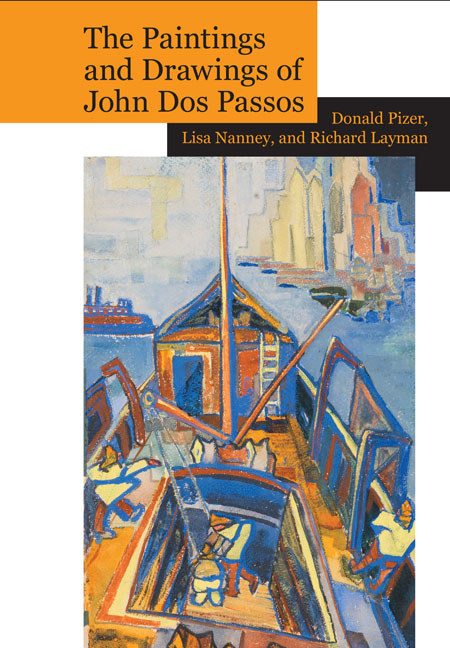Book contents
- Frontmatter
- Contents
- Preface
- Acknowledgments
- The Paintings and Drawings of John Dos Passos: A Collection and Study
- Introduction
- Paintings and Drawings Included in this Volume: A Descriptive List
- Preface to Section 1: Early Work 1918–20
- Preface to Section 2: The Middle East and Morocco 1921–22, 1926
- Preface to Section 3: Paris 1921–25
- Preface to Section 4: New York 1920–24
- Preface to Section 5: New York: Nudes 1920–23
- Preface to Section 6: Theater Designs 1925–28
- Preface to Section 7: Mexico 1926–32
- Preface to Section 8: Later Work 1930–70
- Preface to Section 9: Portraits
- Preface to Section 10: Sea Fronts and Harbors
- Preface to Section 11: Still Lifes
- Preface to Section 12: Studies in Motion
- Preface to Section 13: Abstractions and Other Experimental Modes
- Words and Images: The Visual Art of John Dos Passos
- The Artwork of John Dos Passos
- Notes
- Works Cited
- Index
- Plate section
Preface to Section 11: Still Lifes
from The Paintings and Drawings of John Dos Passos: A Collection and Study
- Frontmatter
- Contents
- Preface
- Acknowledgments
- The Paintings and Drawings of John Dos Passos: A Collection and Study
- Introduction
- Paintings and Drawings Included in this Volume: A Descriptive List
- Preface to Section 1: Early Work 1918–20
- Preface to Section 2: The Middle East and Morocco 1921–22, 1926
- Preface to Section 3: Paris 1921–25
- Preface to Section 4: New York 1920–24
- Preface to Section 5: New York: Nudes 1920–23
- Preface to Section 6: Theater Designs 1925–28
- Preface to Section 7: Mexico 1926–32
- Preface to Section 8: Later Work 1930–70
- Preface to Section 9: Portraits
- Preface to Section 10: Sea Fronts and Harbors
- Preface to Section 11: Still Lifes
- Preface to Section 12: Studies in Motion
- Preface to Section 13: Abstractions and Other Experimental Modes
- Words and Images: The Visual Art of John Dos Passos
- The Artwork of John Dos Passos
- Notes
- Works Cited
- Index
- Plate section
Summary
The still-life watercolors in this volume (figs. 56, 57, 58), most likely date from later in Dos Passos's life, during the 1960s. Their subjects—the fruits, vegetables, and flowers that grew on his land at Spence's Point on the Potomac River in the Northern Neck of Virginia—reflect Dos Passos's interest in agricultural methods and his local landscape once he settled there in 1949. Involvement in the region and its practices and products directed his focus in painting there to what was essential in his environment. Flowers, trees, kitchen gardens, and crops thrived in the productive soil and long growing season of the Northern Neck.
From his extensive European travels as a young man and his habit of closely observing classical art, Dos Passos would have been familiar with the traditions of still-life genre painting, such as seventeenth-century Dutch or Flemish floral images and “kitchen” or “market” paintings. Artists composed such images using unpretentiously common kitchen items and foodstuffs but painted in voluptuous color and detail and mimetic perspective.
Departing significantly from classical still-life conventions, Dos Passos's still lifes resonate instead with the modern and the native. Figure 56, Magnolia, and figure 57, Zucchini and Zucchini Blossom, in particular evoke the essences of their subjects using simplified, often outlined forms and bold colors in flattened perspective. These characteristics of their style recall the aesthetics of the more representational of George Braque's still life oils, such as “Still Life with Fruits” (1924) or “Lemons and Napkin Ring” (1928), which map the French painter's transition away from analytical cubism. Dos Passos's works, however, stop short of the fragmentation Braque introduces into his fully Cubist paintings: though suggesting theories of Cubism in their use of color to create mass in a depthless picture plane, figures 56–58 nonetheless retain an interest in the natural qualities and domestic contexts of their subjects. And while Dos Passos's choices of subjects and his sensuous focus, especially in figures 56 and 57, resemble those in some of the large flower paintings of Georgia O'Keeffe, his work does not share the modernist near-abstraction of those images.
Besides an awareness of Cubism, these paintings also show traces of Post-impressionism and even American regionalism.
- Type
- Chapter
- Information
- Publisher: Liverpool University PressPrint publication year: 2016



